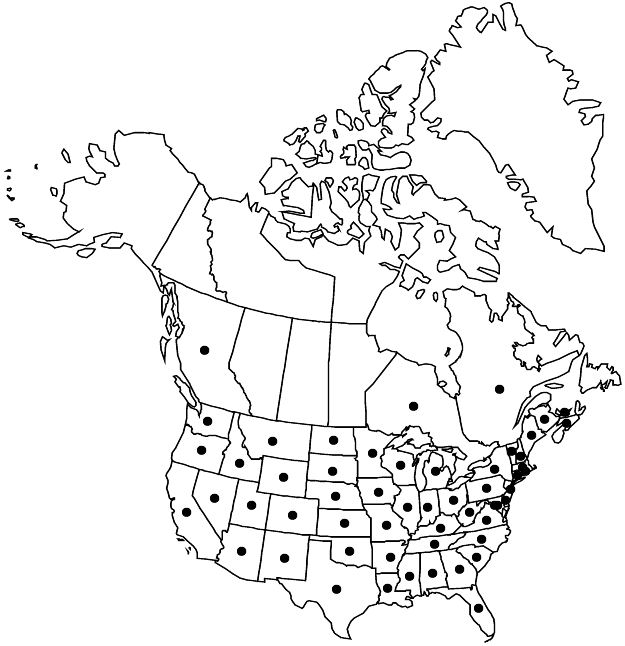Euphorbia maculata
Sp. Pl. 1: 455. 1753.
Herbs, annual, with taproot. Stems usually prostrate, occasionally with ascending tips, often mat-forming, not rooting at nodes, 5–45 cm, densely and evenly short-sericeous to sericeous or villous. Leaves opposite; stipules distinct, linear-subulate, sometimes irregularly 2–3-lobed, 1–1.3 mm, sparsely short-sericeous to sericeous or villous; petiole 0.5–1.5 mm, moderately short-sericeous to sericeous or villous; blade oblong-ovate to ovate-elliptic or oblongelliptic, 4–18 × 2.5–8 mm, base strongly asymmetric, one side usually angled and other ± truncate and expanded into small, rounded auricle, margins serrulate (longer side) or subentire (shorter side), apex rounded or broadly acute, abaxial surface pale grayish green, moderately to densely lanulose to villous, adaxial surface usually with irregular reddish streak along midvein, glabrate or with sparse, long, slender hairs; palmately veined at base, pinnate distally. Cyathia solitary or in small, cymose clusters at distal nodes or on congested, axillary branches; peduncle 0.1–0.6 mm. Involucre obconic, 0.8–1 × 0.6–0.8 mm, sparsely strigose to short-sericeous; glands 4, green to yellow-green, turning pink with age, usually ± unequal, narrowly oblong to nearly linear, 0.1–0.2 × 0.2–0.5 mm; appendages white to reddish tinged, lunate to oblong, 0.1–0.3 × 0.2–1.5 mm, distal margin crenulate. Staminate flowers 2–5. Pistillate flowers: ovary sericeous; styles 0.3–0.4 mm, 2-fid at apex. Capsules ovoid, well exserted from involucre at maturity, 1.3–1.5 × 1.2–1.4 mm, sparsely to moderately and evenly sericeous; columella 1–1.2 mm. Seeds white to light-brown, oblong-ovoid, sharply angular in cross-section, 1–1.2 × 0.6–0.9 mm, with 3–4 low, transverse ridges that cross angles. 2n = 28.
Phenology: Flowering and fruiting spring–fall.
Habitat: Disturbed areas, fallow fields, gardens, sidewalk cracks, railroads, roadsides.
Elevation: 0–1500 m.
Distribution

B.C., N.B., N.S., Ont., P.E.I., Que., Ala., Ariz., Ark., Calif., Colo., Conn., Del., D.C., Fla., Ga., Idaho, Ill., Ind., Iowa, Kans., Ky., La., Maine, Md., Mass., Mich., Minn., Miss., Mo., Mont., Nebr., Nev., N.H., N.J., N.Mex., N.Y., N.C., N.Dak., Ohio, Okla., Oreg., Pa., R.I., S.C., S.Dak., Tenn., Tex., Utah, Vt., Va., Wash., W.Va., Wis., Wyo., Mexico, West Indies, Central America, South America, Eurasia, Africa, Pacific Islands (New Zealand), Australia
Discussion
Euphorbia maculata is a widespread weed in temperate latitudes, and it also occurs in cool climates at higher elevations in the tropics. It is presumed to be native to eastern and central North America, but given its extremely weedy tendencies, it is difficult to know for sure. It spreads readily in association with greenhouse plants and earth-moving activities, and it is notorious for its ability to colonize sidewalk cracks in the summer, even in congested cities. The name E. maculata was misapplied by most earlier botanists (for example, L. C. Wheeler 1941) to plants with ascending stems that are treated here as E. nutans. D. G. Burch (1966) reviewed the sources of data used by Linnaeus in his original description and concluded that the name E. maculata applies to this prostrate-stemmed taxon. For further discussion of the distinctions between E. maculata and the similar 47. E. humistrata, see the treatment of that species.
Selected References
None.
Lower Taxa
"connate" is not a number. "distinct" is not a number."connate" is not a number. "distinct" is not a number.